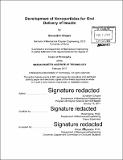Development of nanoparticles for oral delivery of insulin
Author(s)
Chopra, Sunandini
DownloadFull printable version (22.02Mb)
Other Contributors
Massachusetts Institute of Technology. Department of Mechanical Engineering.
Advisor
Rohit Karnik.
Terms of use
Metadata
Show full item recordAbstract
Parenteral administration remains the mainstay of drug administration for protein therapeutics. However, for diseases that require frequent drug dose over long periods of time, injections can result in patient incompliance and poor treatment outcomes. For such diseases, oral drug delivery is the most non-invasive and patient-compliant method of drug administration. Although oral delivery of many small molecule drugs is routine, oral delivery of protein drugs - e.g. insulin presents several challenges including oral bioavailability of the protein therapeutic because of degradation in the stomach, inactivation and digestion of the therapeutics by the proteolytic enzymes in the luminal cavity, and poor permeability of drugs across the intestinal epithelium. Polymeric nanoparticle (NP) carriers provide new opportunities for controlled delivery of drugs, and have the potential to address challenges associated with effective oral delivery of insulin. NPs can protect the protein therapeutic from degradation in the GI tract as well as allow targeted transport across the epithelial lining. An efficient NP based oral insulin delivery solution that can enable targeted transport of insulin across the GI tract must have (1) high insulin loading, (2) sub-100 nm size, (3) ability to release insulin before opsonization by macrophages and (4) the ability to be surface-functionalized with ligands that facilitate transport across the epithelium. This work presents a detailed study on mechanistic understanding of polymeric insulin NP formation with a focus on the effect of synthesis parameters on insulin loading and NP size. We report how buffer conditions, ionic chelation, and NP preparation methods influence insulin loading in poly (lactic-co-glycolic acid)-b-poly(ethylene glycol) (PLGA-PEG) NPs. We report a 10-fold increase in insulin loading with the use of chelating zinc ions and by the optimization of the pH during nanoprecipitation. Next, we report the development of novel insulin Eudragit-PLGA-PEG blended NPs (Ins-Eud-NPs) with high insulin loading (13.1%) and sub-100 nm size. These NPs enable rapid release of insulin when triggered by a change in pH that occurs when the NPs cross the duodenal epithelium and go from acidic to neutral pH. The NPs are formed by successfully blending Eudragit S100, a commercially available polymer which dissolves at pH greater than 7 with a non-pH responsive polymer, PLGA-PEG. To enable effective transport of these NPs across the epithelial lining, NPs were designed to use the FcRn transport pathway that mediates IgG antibody transport across epithelial barriers. We report the successful chemical conjugation of the Fc fragment on the surface of Ins-Eud- NPs by overcoming the presence of non-ideal conjugation parameters owing to the pH restrictions of the system. This dissertation provides mechanistic insights and helps to understand fundamental concepts about polymeric NP formation and protein encapsulation. The modular NP system developed in this work can be extended to other protein drug delivery systems that are subject to limited drug loading and restricted transport across epithelial barriers.
Description
Thesis: Ph. D., Massachusetts Institute of Technology, Department of Mechanical Engineering, February 2017. "February 2017." Cataloged from PDF version of thesis. Includes bibliographical references (pages 151-177).
Date issued
2017Department
Massachusetts Institute of Technology. Department of Mechanical EngineeringPublisher
Massachusetts Institute of Technology
Keywords
Mechanical Engineering.